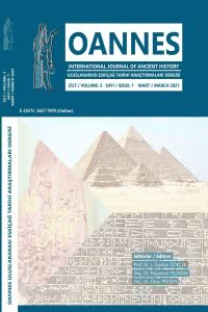Mimari Sembolizm Bağlamında Çanak Çömleksiz Neolitik Dönem’de Bezemeli Taş Levhalar, Kuzey Suriye Örnekleri
Çanak Çömleksiz Neolitik Dönem, Bereketli Hilal, Kuzey Suriye, Kamusal Yapılar, Bezemeli Taş Levhalar, Sosyal Organizasyon, Sosyal Bütünlük
Decorated Stone Slabs in the Context of the Architectural Symbolism in the Pre-Pottery Neolithic Period, the North Syrian
The Pre-Pottery Neolithic Period, Fertile Crescent, North Syria, Public Buildings, Decorated Stone Slabs, Social Organization, Social Cohesion,
___
- AKKERMANS, P.M.M.G - SCHWARTZ, G. M., 2003. Archaeology in Syria. From Complex Hunter-Gatherers to Early Urban Societies (ca. 16.000-3.00 B.C.), Cambridge University Press, Cambridge.
- ASOUTI, E., 2006., “Beyond the Pre-Pottery Neolithic B interaction sphere”, Journal of World Prehistory, 20, ss. 87-126.
- ASOUTI, E. - FULLER, D. Q., 2013., “A Contextual Approach to Emergence of Agriculture in Southwest Asia: Reconstructing Early Neolithic Plant-Food Production. Supplement A: Primary Sources of Archaebothanical Datasets and Radiocarbon Dates from Southwest Asia”, Current Anthropology, 54, ss. 1-79.
- CALLEY, S., 1984. “Le débitage natoufien de Mureybet: étude préliminaire”, Paléorient, 10/2, ss. 35-48.
- CAUVIN, J., 1977. “Archeological Reports from the Tabqa Dam Project: Euphrates Valley, Syria”, The Annual of the American Schools of Oriental Research, 44, Eds.: Freedman, D. N. - Lundquist, J. M., ss. 19-48.
- COQUEUGNIOT, E., 1998. “Dja’de el Mughara (moyen-euphrate), un village neolithique dans son environnment naturel a la vielle de la domestication”, Maison de l'Orient et de la Méditerranée Jean Pouilloux, Ed.: Geyer Bernard, Lyon. ss. 1-8.
- DIETRICH, O. - HEUN, M. - NOTROFF, J. - SCHMIDT, K. - ZARNKOW, M., 2012. “The Role of Cult and Feasting in the Emergence of Neolithic Communities, New Evidence from Göbekli Tepe, Southeastern Turkey”, Antiquity, 86, ss. 674-695.
- KARTAL, M., 2005. Konar-Göçerlikten Yerleşik Hayata Geçiş Epi-Paleolitik Dönem, Arkeoloji ve Sanat Yayınları, İstanbul.
- KODAŞ, E., 2013. “Jerf El-Ahmar Ea 30 Binası Ve Yakındoğu'da PPNA-PPNB'ye Geçiş Dönemine Ait Kamu Binaları”, Tüba-Ar, 16, ss. 9-19.
- KORNIENKO, T. V., 2009. “Notes on the Cult Buildings of Northern Mesopotamia in the Aceramic Neolithic Period”, Journal of Near Eastern Studies, 68/2, ss. 81-102.
- MACBRIDE, A., 2013. “Performance and Participation. Multi-Sensual Analysis of Near Eastern Pre-Pottery Neolithic Non-Domestic Architecture”, Paleorient, 39/2, ss. 47-67.
- MAZUROWSKI, R. F., 2003. “Tell Qaramel Excavations 2003”, Polish Archaeology in the Mediterranean, XV, ss. 355-370.
- ROSENBERG, M., 2007. “Hallan Çemi”, Anadolu’da Uygarlığın Doğuşu ve Avrupa’ya Yayılımı Türkiye’de Neolitik Dönem Yeni Kazılar, Yeni Bulgular, Ed.: Mehmet Özdoğan - Nezih Başgelen, Arkeoloji ve Sanat Yayınları, İstanbul, ss. 1-11.
- ROSENBERG, M - REDDING, R. W., 2000. “Hallan Çemi and Early Village Organization in Eastern Anatolia”, Life in Neolithic Farming Communities, Social Organization, Identity, and Differentiation, Ed.: Kuijt, I., Kluwer Academic Publishers, New York, ss. 39-61.
- SCHMIDT, K., 2007, Göbekli Tepe- Taş Çağı Avcılarının Gizemli Kutsal Alanı, Arkeoloji ve Sanat Yayınları, İstanbul.
- STORDEUR, D., 2000. “New Discoveries and Architecture and Symbolism at Jerf el-Ahmar Syria (1997-1999)”, Neo-Lithics, 1/00, ss. 1-4.
- STORDEUR, D., 2015. Le village de Jerf el Ahmar (Syrie, 9500–8700 av. J.-C.), L'architecture, miroir d'une société néolithique complexe, CNRS, Paris.
- STORDEUR, D. - BRENET, M. - APRAHAMIAN, G. D. - ROUX, J. C., 2000. “Les Batiments de Jerf el-Ahmar et Mureybet Horizon PPN A (Syria), Paleorient, 26/1, ss. 29-44.
- STORDEUR, D. - ABBÈS F. 2002. “Du PPNA au PPNB : mise en lumière d'une phase de transition à Jerf el Ahmar (Syrie)”, Bulletin de la Société préhistorique française, 99/3, ss. 563-595.
- VAN LOON, M., 1968. “The Oriental Institute Excavations at Mureybit, Syria: Preliminary Report on the Campain: Part 1: Architecture and General Finds”, Journal of Near Eastern Studies, 27/4, ss. 265-282.
- VERHOEVEN, M., 2002. “Ritual and ideology in the Pre-Pottery Neolithic B of the Levant and Southeastern Anatolia”, Cambridge Archaeological Journal, 12/2, ss. 233-258.
- WATKINS, T., 2004. “Architecture and “Theatres of Memory” in the Neolithic of Southwest Asia”, Rethinking materiality, Engagement of Mind with Material World, Eds.: Demarrais, E. - Gosden, C. - Renfrew, C., Mcdonald Institute Monographs, Cambridge, ss. 97-106.
- WATKINS, T., 2015. “Ritual Performance and Religion in Early Neolithic Societies”, Defining the Sacred: Approaches to the Archaeology of Religion in the Near East, Ed:. Laneri, N., Oxbow Books, Oxford, ss. 153-160.
- WATKINS, T., 2017. “Architecture and Imagery in the Early Neolithic of South-West Asia: Framing Rituals, Stabilising Meanings”, Ritual, Play and Belief in Evolution and Early Human Societies, Eds.: Renfrew C. - Morley, I. - Boyd M., Cambridge University Press, Cambridge, ss.129-142.
- WILLCOX, G., 2002. “Charred plant remains a 10th millenium B.P. kitchen at Jerf el-Ahmar (Syria)”, Veget Hist Archaeobot, 11, ss. 55–60.
- YARTAH, T., 2004. “Tell 'Abr 3, un village du néolithique précéramique (PPNA) sur le Moyen Euphrate. Première approche”, Paléorient, 30/2, ss. 141-158.
- YARTAH, T., 2013. Vie quotidienne, vie communautaire et symbolique à Tell 'Abr 3 – Syrie du Nord Données nouvelles et nouvelles réflexions sur L’horizon PPNA au nord du Levant. 10 000-9 000 BP”, L’université Lumière – Lyon 2, Faculté de Géographie, Histoire, Histoire de l’Art et Tourisme (Yayınlanmamış Doktora Tezi).
- ISSN: 2667-7059
- Yayın Aralığı: 2
- Başlangıç: 2019
- Yayıncı: Okay PEKŞEN
Tavşan Dağları’nda Antik Bir Yol
Eskiçağ’daki Adam – Aslan İlişkisinin Zooikonografik Analizi
Eski Hellen Literatüründe İlahi Cezalandırmanın Tezahürü Olarak Veba Metaforu: İki Örnek
Hitit Toprak Bağış Belgeleri Hakkında Genel Bir Değerlendirme
Yukarı Göklü Nekropolü'nden Bir Grup Süs İğnesi
Akadlı Sargon’un Mezopotamya Hâkimiyetinde Enḫeduanna’nın Rolü
